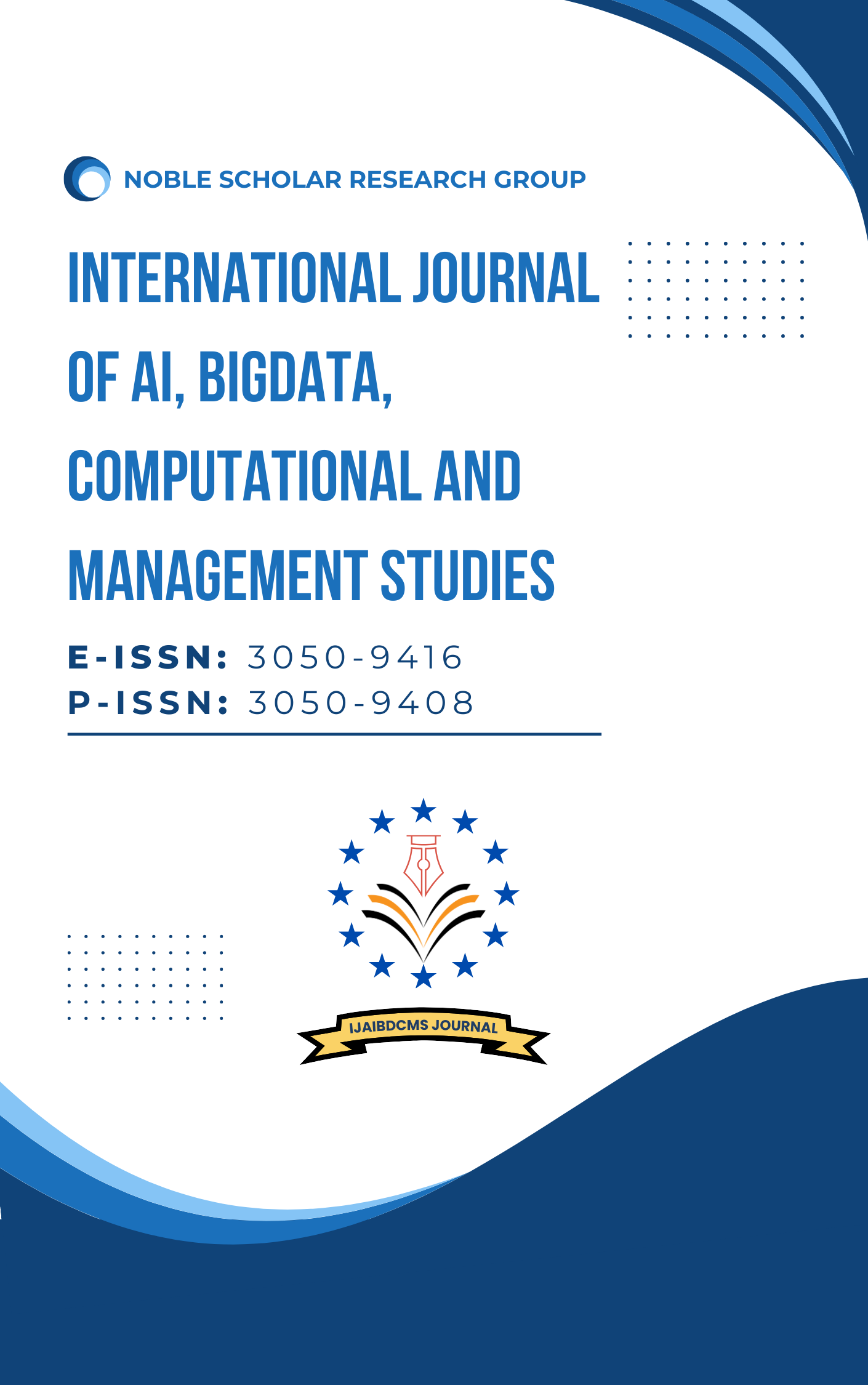Autonomous IoT: AI-Driven Edge Computing to Power Intelligent Decision-Making
DOI:
https://doi.org/10.63282/3050-9416.IJAIBDCMS-V3I2P106Keywords:
Autonomous IoT, Edge Computing, Artificial Intelligence, Machine Learning, Edge AI, Federated Learning, Intelligent Decision-Making, Smart Cities, TinyMLAbstract
The IoT is quickly changing industries by providing extensive network connections across devices and collecting a large amount of data. However, traditional models deployed on a cloud-only paradigm experience problems with latency, maximum bandwidth to be utilized, and live decision-making procedures. To overcome these challenges, innovative IoT systems that are Autonomous integrated and powered by AI Edging Computing are becoming an innovative concept. It is most commonly referred to as distributed computing, which involves data analysis near the point of sensors, which helps achieve fast processing and decision-making without much dependence on cloud computing. Edge AI has many benefits including the efficient usage of resources, greater protection, lower delay times, and enabling the device to make decisions on its own. In this context, this paper aims at providing an elaborate insight into AI based Edge Computing to improve the sophistication of the Autonomous IoT architectures. First, it discusses the shortcomings of typical IoT architectures and the relevancies of decentralizing intelligence. Subsequently, it overviews current research progress and stems from understanding how ML, DL, and FL models are being implemented at the edge, addressing predictive analytics, anomaly detection, and system optimisation. To further explain the proposed approach, designing an overall system flow of the edge-based IoT framework with AI, including connection to sensors, performing inference, updating models, and auto-actuating cycles. This is about the application of the Edge AI in the Smart city smart system models on a low compute device such as Jetson Nano, Google Coral and the like. It has been established that there is up to 70% improvement in latency, higher reliability of the system, and efficient decision-making compared to those relaying in the cloud. Besides, they are concerned with limitations like limited computing capability, pruning and quantization, privacy preservation, and emerging Tiny ML and Neuromorphic computing areas. In this way, making clear experiments, flow diagrams, tables, and figures, this investigation offers a practical guide for the researchers and engineers interested in constructing successful accepting, flexible, and smart IoT systems with the help of Edge computing for the future
References
1. Atzori, L., Iera, A., & Morabito, G. (2010). The internet of things: A survey. Computer Networks, 54(15), 2787-2805.
2. Djelouat, H., Amira, A., & Bensaali, F. (2018). Compressive sensing-based IoT applications: A review. Journal of Sensor and Actuator Networks, 7(4), 45.
3. Bonomi, F., Milito, R., Natarajan, P., & Zhu, J. (2014). Fog computing: A platform for the Internet of things and analytics. Big data and internet of things: A roadmap for smart environments, 169-186.
4. Yi, S., Li, C., & Li, Q. (2015, June). A survey of fog computing: concepts, applications and issues. In Proceedings of the 2015 workshop on mobile big data (pp. 37-42).
5. Habibi, P., Farhoudi, M., Kazemian, S., Khorsandi, S., & Leon-Garcia, A. (2020). Fog computing: a comprehensive architectural survey. IEEE Access, 8, 69105-69133.
6. Mukherjee, M., Shu, L., & Wang, D. (2018). Survey of fog computing: Fundamental, network applications, and research challenges. IEEE Communications Surveys & Tutorials, 20(3), 1826-1857.
7. Shi, W., Cao, J., Zhang, Q., Li, Y., & Xu, L. (2016). Edge computing: Vision and challenges. IEEE internet of things journal, 3(5), 637-646.
8. Al-Fuqaha, A., Guizani, M., Mohammadi, M., Aledhari, M., & Ayyash, M. (2015). Internet of Things: A survey on enabling technologies, protocols, and applications. IEEE communications surveys & tutorials, 17(4), 2347-2376.
9. Nguyen, D. C., Ding, M., Pathirana, P. N., Seneviratne, A., Li, J., & Poor, H. V. (2021). Federated learning for Internet of things: A comprehensive survey. IEEE Communications Surveys & Tutorials, 23(3), 1622-1658.
10. Sodhro, A. H., Pirbhulal, S., & De Albuquerque, V. H. C. (2019). Artificial intelligence-driven mechanism for edge computing-based industrial applications. IEEE Transactions on Industrial Informatics, 15(7), 4235-4243.
11. Deng, S., Zhao, H., Fang, W., Yin, J., Dustdar, S., & Zomaya, A. Y. (2020). Edge intelligence: The confluence of edge computing and artificial intelligence. IEEE Internet of Things Journal, 7(8), 7457-7469.
12. Kyriazis, D., & Varvarigou, T. (2013). Smart, autonomous and reliable Internet of Things. Procedia Computer Science, 21, 442-448.
13. Khayyam, H., Javadi, B., Jalili, M., & Jazar, R. N. (2019). Artificial intelligence and the Internet of Things for autonomous vehicles. In Nonlinear approaches in engineering applications: Automotive applications of engineering problems (pp. 39-68). Cham: Springer International Publishing.
14. Campolo, C., Genovese, G., Iera, A., & Molinaro, A. (2021). Virtualizing AI at the distributed edge towards intelligent IoT applications. Journal of sensor and actuator networks, 10(1), 13.
15. Ammar, M., Russello, G., & Crispo, B. (2018). Internet of Things: A survey on the security of IoT frameworks. Journal of Information Security and Applications, 38, 8-27.
16. Wang, X., Han, Y., Wang, C., Zhao, Q., Chen, X., & Chen, M. (2019). In-edge ai: Intelligentizing mobile edge computing, caching and communication by federated learning. Ieee Network, 33(5), 156-165.
17. Nguyen, D. C., Ding, M., Pham, Q. V., Pathirana, P. N., Le, L. B., Seneviratne, A., ... & Poor, H. V. (2021). Federated learning meets blockchain in edge computing: Opportunities and challenges. IEEE Internet of Things Journal, 8(16), 12806-12825.
18. El-Sayed, H., Sankar, S., Prasad, M., Puthal, D., Gupta, A., Mohanty, M., & Lin, C. T. (2017). Edge of things: The big picture on integrating edge, IoT and the cloud in a distributed computing environment. I.e. access, 6, 1706-1717.
19. Yu, W., Liang, F., He, X., Hatcher, W. G., Lu, C., Lin, J., & Yang, X. (2017). A survey on the edge computing for the Internet of Things. IEEE Access, 6, 6900-6919.
20. Hamdan, S., Ayyash, M., & Almajali, S. (2020). Edge-computing architectures for Internet of things applications: A survey. Sensors, 20(22), 6441.



